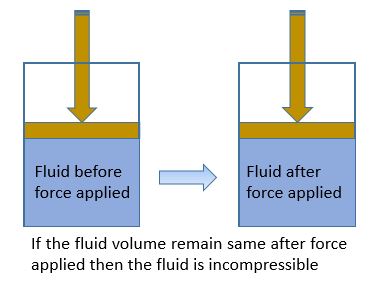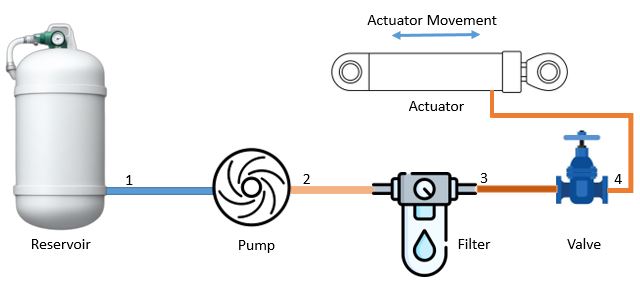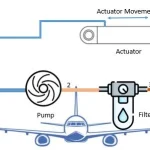Hydraulic systems have played a pivotal role in various industries, offering an efficient and powerful means of transmitting energy. These systems leverage the incompressibility of hydraulic fluids to transmit force, making them indispensable in applications ranging from heavy machinery to aerospace. In this article, we will explore the key components of hydraulic systems and their diverse applications.
Principles behind hydraulic systems
The fundamental concept governing hydraulic systems relies on Pascal’s principle. According to Pascal’s law, any alteration in pressure exerted on a confined fluid is transmitted without reduction to every part of the fluid and the boundaries of its enclosure.
In the context of hydraulic systems, this principle is fundamental to understanding how force can be efficiently transmitted through a fluid to perform mechanical work. Let us illustrate the principle and how things can be done.
Explanation of hydraulic systems principles

Incompressibility of Fluids:
Hydraulic systems rely on the incompressibility of fluids, usually hydraulic oil. Unlike gases, fluids are generally incompressible, meaning that when pressure is applied to a fluid, it transmits that pressure equally in all directions. This property is crucial for the effective transfer of force within the system.
Pascal’s Law:
Pascal’s law forms the foundation of hydraulic systems. According to this law, any change in pressure applied to a confined fluid (incompressible) is transmitted undiminished in all directions.
In the context of a hydraulic system, this means that when force is applied to a small area (such as through a piston), the resulting pressure change is transmitted through the hydraulic fluid and exerted on a larger area (such as a larger piston or hydraulic actuator).
Hydraulic Pressure and Flow:
The hydraulic system generates pressure by using a pump to push the hydraulic fluid into a closed system. According to Pascal’s law this pressure will be transmitting all directions equally. If we allow this pressure to release in a desired direction, it can be utilized to perform desired work.
The flow of hydraulic fluid is controlled by valves, regulating the direction and speed of the fluid within the system.
Hydraulic Cylinders and Motors:

As we are saying in the previous paragraph to release the pressure to a desired direction here is the mechanism for this. Hydraulic cylinders and motors are key components that convert hydraulic pressure into mechanical force or motion.
A hydraulic cylinder, for instance, consists of a piston inside a cylinder filled with hydraulic fluid. When pressure is applied to one side of the piston, it moves, and this motion can be harnessed to perform work, such as lifting heavy loads. Hydraulic motors operate similarly but provide rotational motion.
Control Valves:

Control valves within hydraulic systems manage the movement of hydraulic fluid, overseeing the fluid’s direction, pressure, and velocity. This precise control allows for the efficient and controlled movement of hydraulic actuators.
In summary, the principle behind hydraulic systems involves using Pascal’s law and the incompressibility of fluids to transmit force and control motion. By manipulating the pressure and flow of hydraulic fluid, these systems can perform a wide range of tasks in various industries, from lifting heavy objects in construction equipment to controlling aircraft landing gear in the aerospace industry.
Components of Hydraulic Systems

Hydraulic Fluid:
The primary element in a hydraulic system is the hydraulic fluid. Typically, oil-based fluids are used due to their incompressible nature, high viscosity, and ability to withstand extreme temperatures. The hydraulic fluid is crucial for the efficient transfer of energy within the system.
Reservoir:
The reservoir functions as a storage container for hydraulic fluid. It allows for the dissipation of heat, removal of contaminants, and ensures a constant supply of fluid to the pump. Proper maintenance of the reservoir is essential for the longevity and efficiency of the hydraulic system.
Pump:
The pump is responsible for converting mechanical energy (Rotation) into hydraulic energy (Pressure). There are various types of pumps, such as gear pumps, vane pumps, and piston pumps. Each type has its own advantages and is chosen based on the specific requirements of the application.
Actuators:
Actuators are devices that help to transmit hydraulic energy into mechanical energy. The two primary types of actuators are hydraulic cylinders and hydraulic motors. Hydraulic cylinders are used for linear motion, while hydraulic motors provide rotational motion. These actuators play a crucial role in powering the movement of heavy machinery and equipment.
Valves:
Valves manage the movement of hydraulic fluid within the system. They regulate pressure, direction, and volume, ensuring precise control over the hydraulic machinery. Common types of valves include control valves, relief valves, and check valves.
Filters:
Filters are installed in the hydraulic system to remove contaminants and particles from the fluid. Clean hydraulic fluid is essential for preventing damage to the components and ensuring the system’s reliability.
Applications of Hydraulic Systems
- Construction Industry:
- Hydraulic systems are extensively used in construction equipment such as excavators, bulldozers, and cranes. The power and precision offered by hydraulic systems make them ideal for heavy-duty applications.
- Aerospace:
- Hydraulic systems are crucial in aircraft for controlling landing gear, flaps, and other critical components. Their reliability and ability to handle high forces make them indispensable in the aerospace industry.
- Automotive Industry:
- Hydraulic systems are present in various automotive applications, including brake systems and power steering. They provide efficient and reliable solutions for controlling vehicle movement and safety.
- Manufacturing and Factory Automation:
- Hydraulic systems are employed in manufacturing machinery for processes such as metal forming, injection molding, and material handling. Their ability to provide precise control contributes to increased efficiency in industrial processes.
Conclusion
Hydraulic systems have become an integral part of numerous industries, offering unparalleled power, control, and efficiency. The careful integration of components like pumps, actuators, valves, and filters ensures the reliable and smooth operation of hydraulic systems across diverse applications. As technology continues to advance, hydraulic systems are likely to evolve, providing even more innovative solutions to meet the demands of modern industries.



